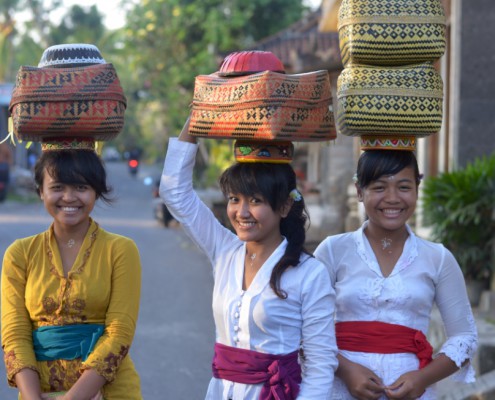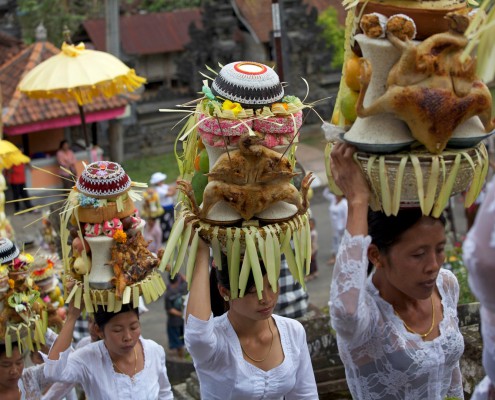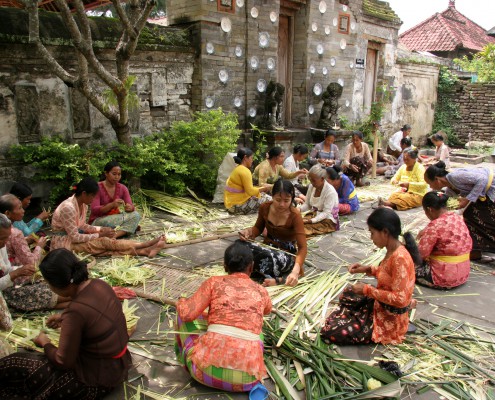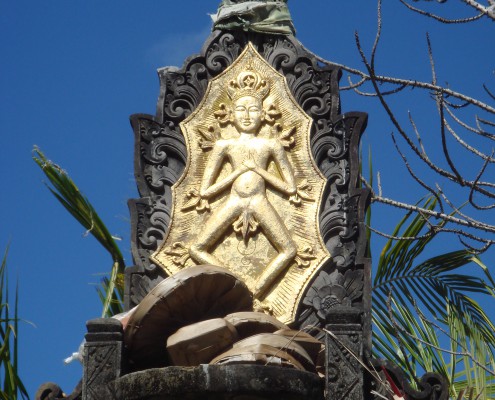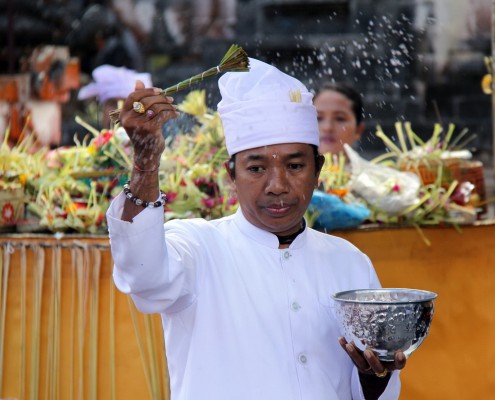Bali island
The area of the island is 5561 km² and is considered to be the westernmost of the Lesser Sunda Islands. The capital of Bali is Denpasar. The province of Bali lies in the Indian Ocean between Java and Bali. The north-south extension is 95 km, from its western tip to the eastern tip it is 145 km. Up to six vegetation zones can be found in Bali: Tropical rainforest, cloud forest, wet savannah, mangrove forests, lava landscape and cultivated landscape (e. g. rice terraces).
The faura and flora are hardly different from the Malaliian mainland. There are also snakes, wildlife such as street dogs and cats, monkeys, lizards and in the rainforests there are also snakes, wildlife and red deer, as well as many different bird species, including the Bali-born Bali star. Off Bali’s coast there are extensive coral reefs that invite you to snorkel or watch dolphins. Three quarters of the island’s total surface is covered by volcanic mountains. The volcano Gunung Agung is the highest mountain of the island and the seat of the gods with 3031 meters. To the west of the Agung is the huge, ten-kilometer-wide volcanic crater of the Batur massif.
Bali Facts
- Ø Annual Temperature28.5 °C
- Rainy seasonNovember-March
- Dry seasonApril-September
- Capital cityDenpasar
- Area5561 km²
- Inhabitants4.22 Million
- Mt. Agung3031 meters
Balinese local people
Bali is home to about 4.5 million inhabitants. About 700,000 of them live in the city of Denpasar, which is located to the south (translated’ Central Market’, also known as the Pasar in Dutch colonial times). In the centre of the city is Puputan Square. The vast majority of the island’s population are Hindu Balinese, but the proportion of immigrants from Java, other Asian countries, Australia and Europe is increasing.
The daily life in the traditional Balinese family association follows strict rules, consisting of religious ceremonies and traditional rites, but this way of life is increasingly being lost in tourist areas.
Nevertheless, the Balinese mentality is permeated by helpfulness, friendliness and business acumen. This also explains the fact that the Balinese usually face the visitor with a smile. Smile is an expression of dignity and respect in Bali. You will find that with a smile everything works much faster and better, even if a service is rejected. As a traveller, it is a good idea to get rid of the European body language for the duration of your stay and to adopt the pleasant, courteous Balinese language – smile and friendliness.
The less populated areas are located in the west and north of the island. There you can also find the original naturalness of the people who are more than 90 percent active in agriculture.
Balinese language
The national languages are Balinese, which is an independent language and the official language Bahasa Indonesia (literally: Indonesian language). Especially in tourist centres English and sometimes German is spoken. But don’t worry, if a linguistic problem arises, a suitable interpreter is immediately sought who understands and translates at least a few words. Talking with hands and feet is a popular and for both sides extremely amusing experience, which is always carried out with kindness, enthusiasm and perseverance.
Balinese Climate
The climate on Bali is tropical since its near to the equator. This means that temperatures are relatively constant throughout the year. Temperatures vary between 22 and 34 degrees Celsius. The annual average is 28.5 degrees Celsius. Even in the coolest months, temperatures never fall below 22 degrees. At night, no temperature drops below this mark are also to be expected.
These temperatures apply to sea level. However, Bali is full of volcanoes and mountains. The highest is the Gunung Agung (3100 meters). At these altitudes, the temperatures are of course much lower. Even though the temperatures hardly fluctuate, the thermometer can drop to 10 degrees Celsius at night. During the day it barely climbs higher than 20 degrees.
Traditional balinese food
Bali’s food is an Asian-Indo-European mix and especially varied. Balinese cuisine was influenced by both Western and Eastern cultures.
The food of the day is sacrificed daily before people eat it. In Bali, rice is the main food and cannot be excluded from any of the local dishes. Occasional side dishes are also cassava and potatoes. The main crop besides rice is coconut, which is often used for curry dishes. The spices garlic, ginger, cardamom, palm sugar, yellow spice and especially chilli are widespread in Bali. Beef is available for tourists in restaurants and fast food chains, while the Balinese consider the cow sacred. On Bali there is something for every taste and the dishes are prepared in pans, charcoal barbecues and woks – in small stalls on the side of the road, fast food chains and top restaurants.
Typical dishes are Babi Guling, Nasi Campur (rice dish with various meats and vegetables), Nasi Goreng (roasted rice) and Mie Goreng (fried noodles), Sate (grilled meat skewers with chicken, lamb, beef or crabs). Eating and drinking in Indonesia is generally very cheap, except in luxury hotels.
Balinese Ceremonies
The family celebrations consist of ceremonies around the child, tooth filing, wedding ceremony and the burning of corpses.
A first cleansing ceremony is held before the birth. The pregnant woman is considered to be unclean and is not allowed to enter the temples. A special ceremony takes place after birth. The four siblings (kanda empat) – placenta, umbilical cord, amniotic fluid and blood – are placed in a coconut shell and then buried. On the 12th day, the newborn baby is given a temporary name which is changed again on the 105th day. After 210 days (one Bali year) the child’s head is shorn and a last sacrifice is made to the children’s god Rare Kumara. The following birthdays are, unlike with us, not particularly noted. Old Balinese people don’t even know their exact birthday.
The teeth ritual (metatah) should be carried out before the wedding if possible and is very important for the Balinese. A priest adjusts the six upper front teeth by filing the incisors. The background to this is the idea that humans differ from animals by having teeth of equal length. This ceremony ritually frees the Balinese from animal desires, lust, rage, greed and envy. From now on, one possesses the maturity of an adult.
In the last few years it has become clear that this ceremony, which is very expensive, is only carried out after the wedding. Often, for reasons of cost, one waits for a reasonable time to have all children of the family (including nephews, nieces, etc.) join in the ceremony.
The wedding is also subject to a change of times. In the past, parents had already made arrangements for a later marriage before the birth of the children. These agreements were often made for social and economic reasons and did not take into account whether the partners loved each other or not. A marriage outside the box was also unthinkable.
Apart from the 10% of the population, who belong to a higher caste and still behave very traditionally on this issue, the young adults, as in Europe, usually choose their own partner. Premarital sex was once a taboo. Nowadays, the reason why marriage is performed head over heels is often the fact that the young woman is pregnant.
The manner in which a wedding ceremony is held varies from region to region. It also depends on the purse of the person concerned how costly the ceremony is. However, it is widespread everywhere that the parents symbolically negotiate a bride’s price in the presence of priests and village superiors and give their consent to the marriage. The woman moves into the husband’s house and becomes a member of his Banjar.
The most important event in the life of the locals is the Cremation Ceremony, a gift. A burning, which takes place on a place at the cemetery near the village, can be seen as a tourist.
Especially in the last third of the year, numerous burns occur. The western observer is usually surprised that the ceremony is very colourful and above all cheerful. But there is also every reason to rejoice, because the Balinese believe in rebirth and come one step closer to their goal of reunification with God.
The combustion ceremony itself can be very different. It depends on who died when, where and possibly how he died. Generally speaking, however, it can be said that animal sarcophaguses (different according to caste) and incineration towers are produced. A Brahmin (upper priest) presides over the ceremony. From the deceased’s homestead (s) the cremation tower is zigzagged with twists and turns (so that the soul cannot find its way back) and brought to the cemetery with a lot of noise. The body is then burned in the sarcophagus. The ash and bone remains of the corpse are collected, washed, placed in a white cloth and brought to the sea (or a river leading to the sea) in a procession. Of course, the preparation of this ceremony takes a lot of time and all the family clan’s helpful hands are needed.
Since gifts are also a costly ceremony, the carrying out of which is the duty of the sons, one sometimes waits until a rich man of the village makes a burn. You can then join this ceremony (at a lower cost). The locals jokingly call it “riding the bus”. It is not uncommon for couples who are unable to have children to adopt a child so that the cycle of birth, death and rebirth is not interrupted.


